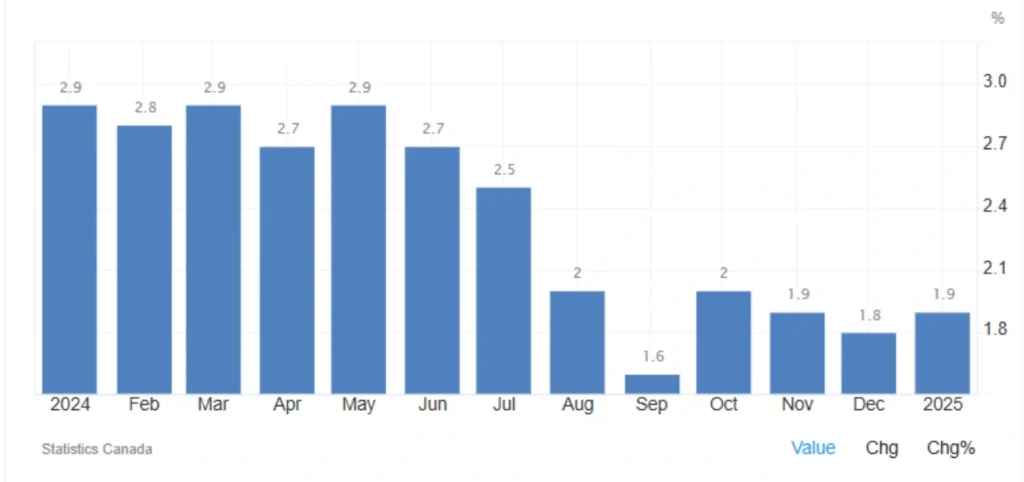
Canada’s Inflation Rate Increase in January 2025
Canada’s annual inflation rate saw a small uptick in January 2025, reaching 1.9%, slightly higher than the 1.8% recorded in December. This increase is in line with market expectations, maintaining inflation at or below the Bank of Canada’s (BoC) 2% target for the sixth consecutive month. As inflation stays steady, speculation grows around the Bank of Canada’s potential to continue its cycle of interest rate cuts. But what does this all mean for consumers, investors, and the economy at large? Let’s break it down.
Key Factors Driving the Inflation Increase
While the uptick in inflation is minor, several key factors contributed to this shift in Canada’s economic landscape:
1. Transportation Prices on the Rise
Transportation costs experienced a significant boost, rising to 3.4% from 2.3% in December. This change is largely attributed to higher oil and natural gas prices, which caused a notable 8.6% increase in gasoline prices. Compare this to the 3.5% increase seen in December, and it’s clear that energy prices are having a direct impact on inflation.
2. Passenger Vehicle Prices Bounce Back
For the first time in eight months, passenger vehicle prices rose by 0.4%. This increase, while modest, indicates that the automotive sector is recovering from previous slowdowns and rising costs in the manufacturing supply chain.
3. Housing Inflation Holds Steady
Inflation in the housing sector remained unchanged at 4.5%, signaling stability in this crucial area. With housing costs being a major concern for many Canadians, this steady rate offers a level of reassurance for consumers.
4. Food Prices Fall Slightly
In an unexpected turn, food prices dropped by 0.6% in January, compared to a 0.6% rise in December. The decrease is largely due to a reduction in taxes on food, which provided a slight relief to Canadian shoppers.
5. Core Inflation Measures: A Closer Look
The Bank of Canada’s preferred core inflation measures, such as the trimmed mean and median, held steady at 2.7%. This figure is slightly above market expectations, suggesting that underlying inflationary pressures still exist in parts of the economy.
Read More: Canada Balance of Trade
Why These Changes Matter
With inflation still within the Bank of Canada’s target range, there are several important implications to consider.
Signaling Future Interest Rate Cuts
The continued stabilization of inflation around the BoC’s 2% target strengthens expectations for a continuation of the central bank’s interest rate cuts. As inflation remains under control, the likelihood of further easing monetary policy increases, which could have wide-reaching effects on borrowing costs and the economy as a whole.
Impact on Consumer Spending
Food price reductions may ease some of the financial pressure on consumers, supporting purchasing power. However, higher transportation costs could weigh on household budgets, particularly for those who rely on cars for commuting and daily activities.
Potential Future Policy Shifts
If inflation remains subdued, it’s likely that the Bank of Canada will continue to lower interest rates. This would further stimulate economic activity, but the exact pace and timing of any additional rate cuts remain uncertain.
Understanding Inflation’s Impact on the Bank of Canada’s Policies
For those trying to make sense of the Bank of Canada’s strategies, it’s important to understand how inflation directly influences the central bank’s decisions.
What is Inflation and Why Should You Care?
Inflation refers to the general rise in prices across an economy. If inflation becomes too high, it reduces consumers’ purchasing power. On the other hand, extremely low inflation can signal economic stagnation or recession. Keeping inflation at a balanced level is crucial for maintaining a stable economy.
The BoC’s 2% Inflation Target
The Bank of Canada targets an inflation rate of 2%, with a range of 1% to 3%. This target helps ensure economic stability and guides both business and consumer decision-making. By keeping inflation in this range, the Bank of Canada provides a reliable framework for long-term planning.
How Does the BoC Control Inflation?
The central bank uses interest rates to control inflation. If inflation is too high, it raises interest rates to make borrowing more expensive, which reduces spending and helps curb price increases. Conversely, if inflation is too low, the BoC lowers interest rates to stimulate borrowing and investment, boosting economic activity.

The Broader Market Impact
Inflation rates also have significant effects on various financial markets, including the currency, stock, and real estate markets.
Impact on Currency
When the Bank of Canada cuts interest rates, it can cause the Canadian dollar to depreciate. While this may make Canadian exports more competitive, it also raises the cost of imports, which could contribute to inflation in other sectors.
Impact on Stocks
Lower interest rates are generally seen as positive for the stock market, as cheaper borrowing costs reduce expenses for companies and can lead to increased profitability and investment.
Impact on Real Estate
Lower interest rates often increase demand for mortgages, which in turn can drive up real estate prices. This trend could be particularly beneficial for those looking to enter the housing market or refinance existing loans.
Conclusion: What’s Next for Canada’s Inflation?
In January 2025, Canada’s inflation rate edged up to 1.9%, staying well within the Bank of Canada’s target range. With inflation remaining controlled, it’s likely that the central bank will continue to pursue interest rate cuts in the near future. This provides opportunities for consumers and investors, but it’s essential to stay informed about future inflation trends. Keep an eye on how interest rate changes could affect your financial situation, whether you’re managing personal finances, investing, or planning for long-term goals.
Share
Hot topics

Will 2026 Be a Turning Point for Crypto Regulation in the U.S.?
The cryptocurrency world is gearing up for a transformative year as a pro-crypto administration, led by Donald Trump, prepares to take charge in the United States. With a Congress expected...
Read more




Submit comment
Your email address will not be published. Required fields are marked *